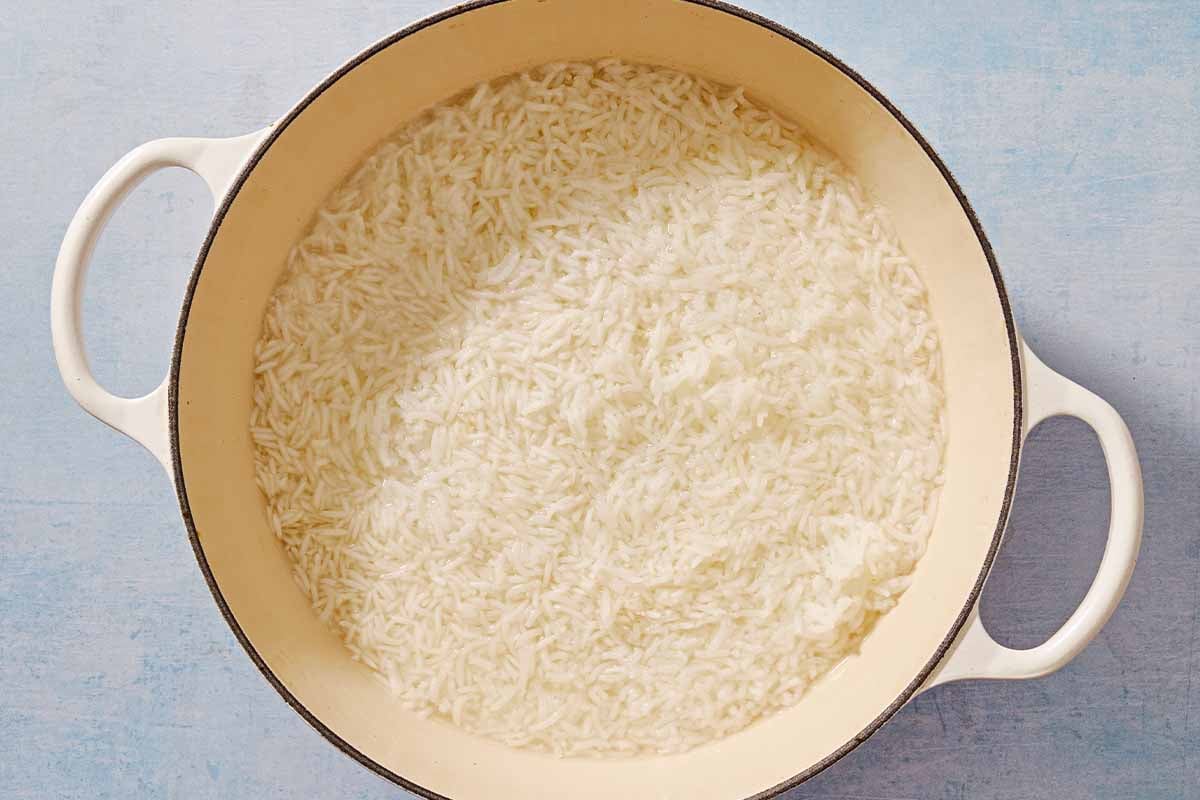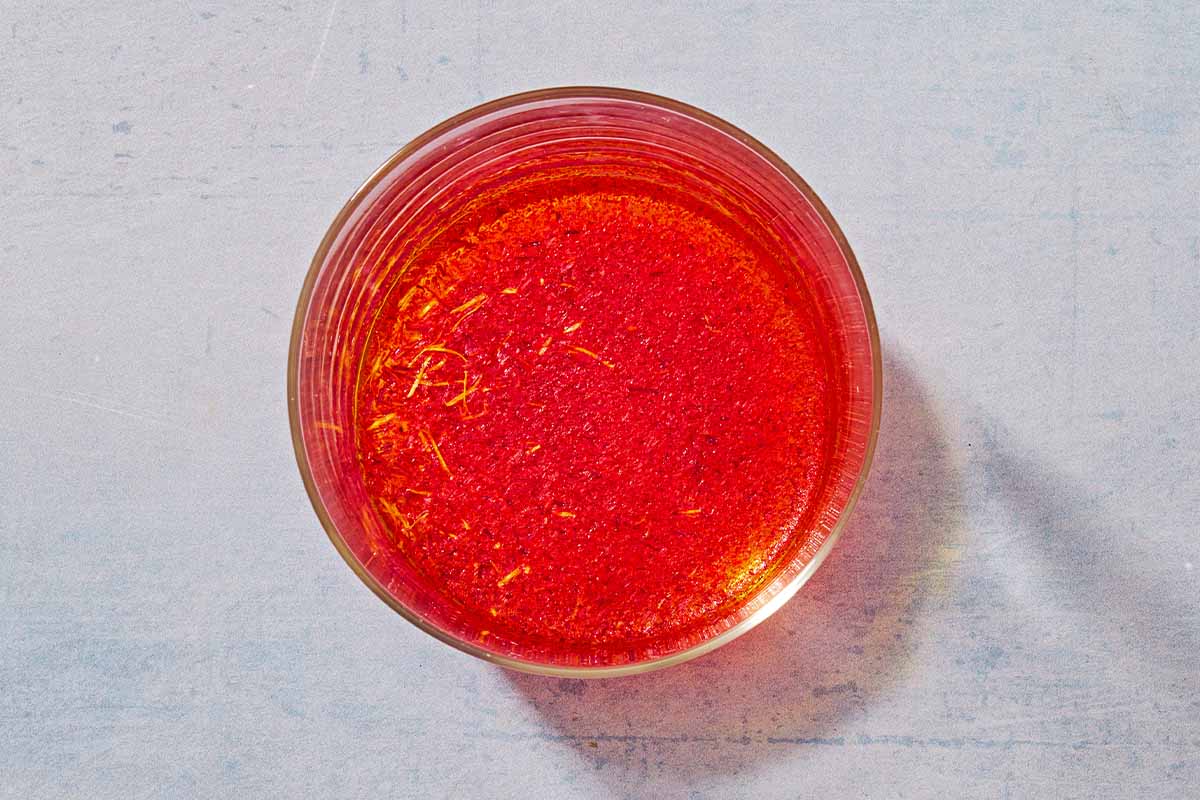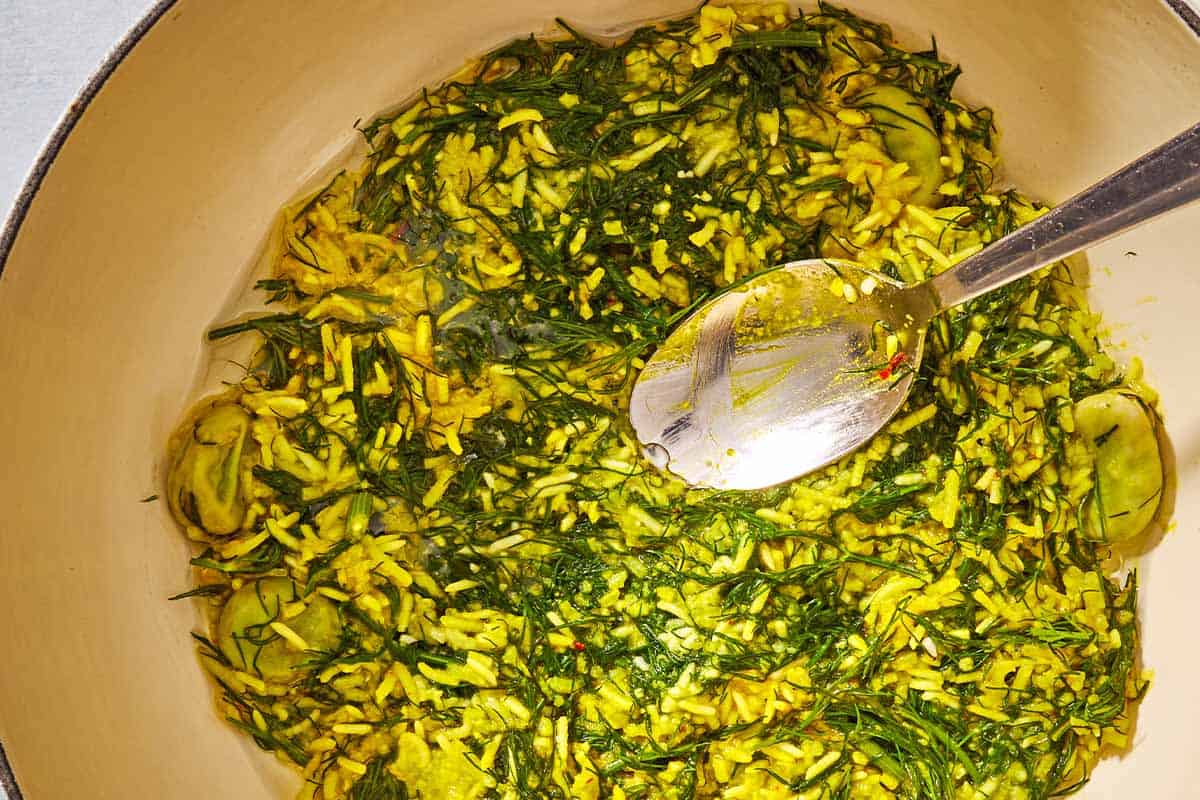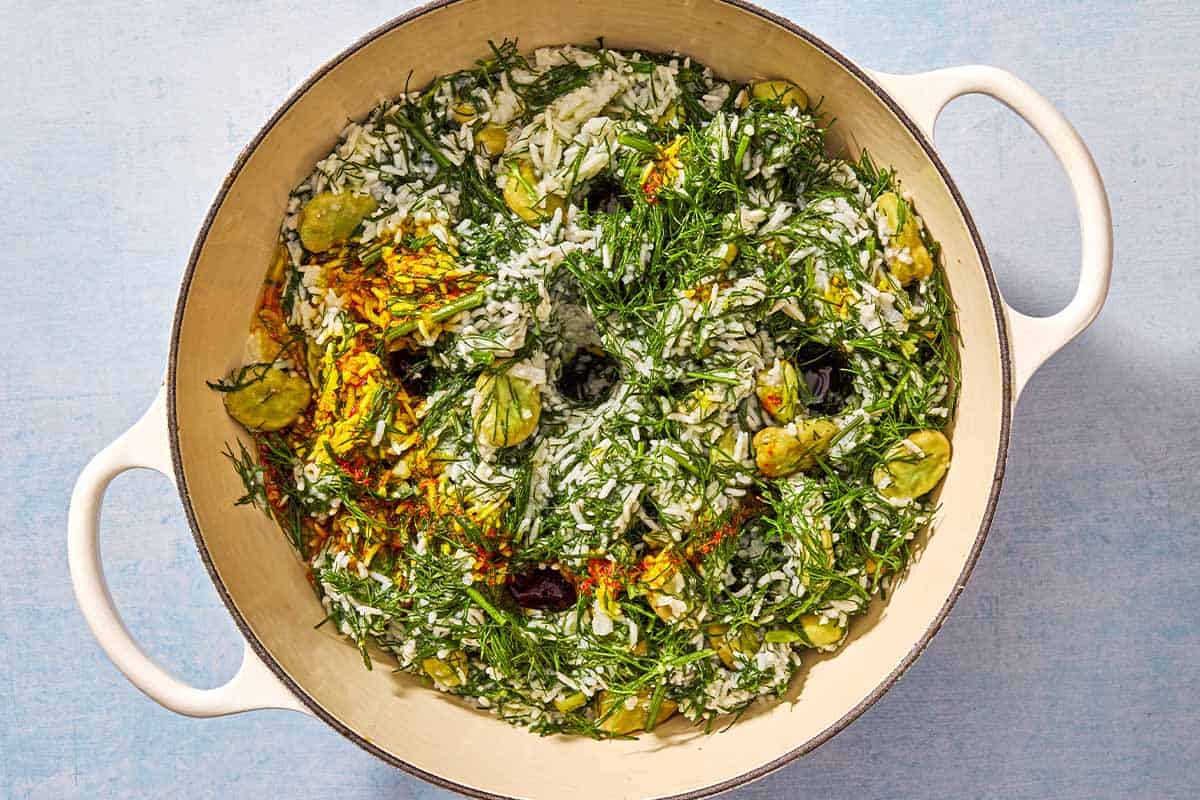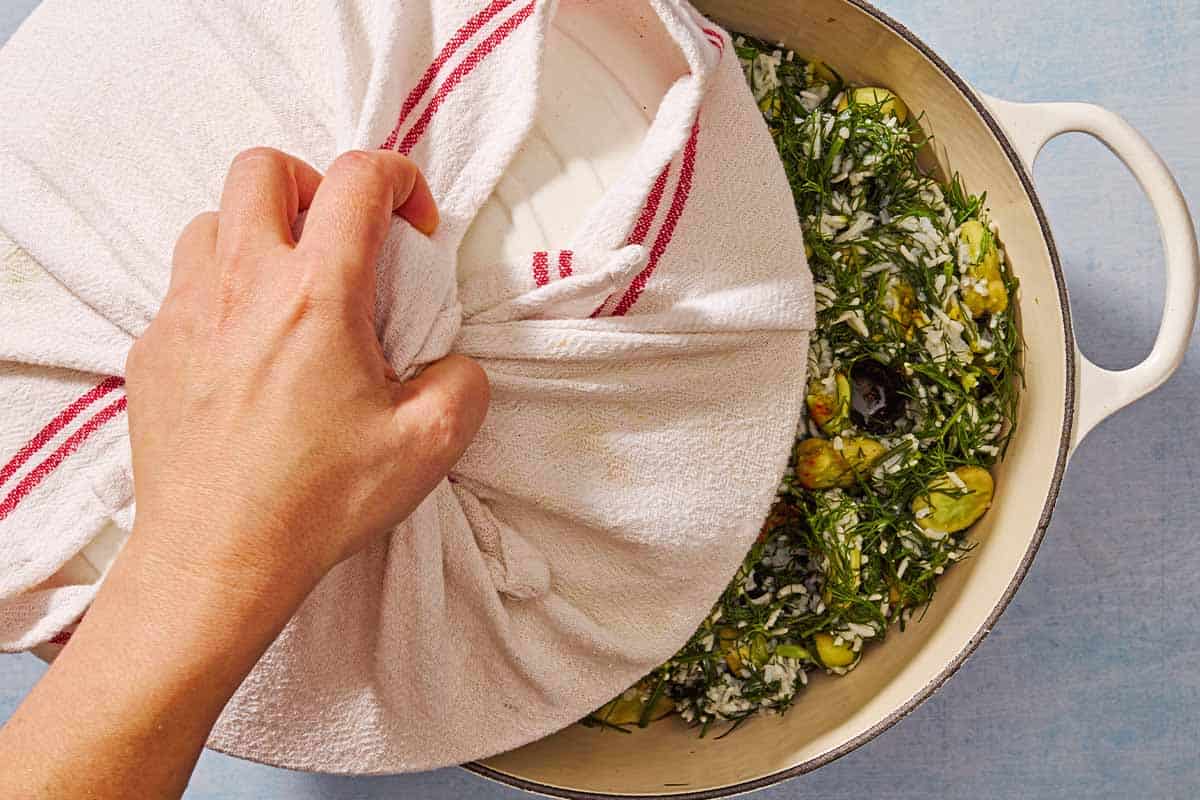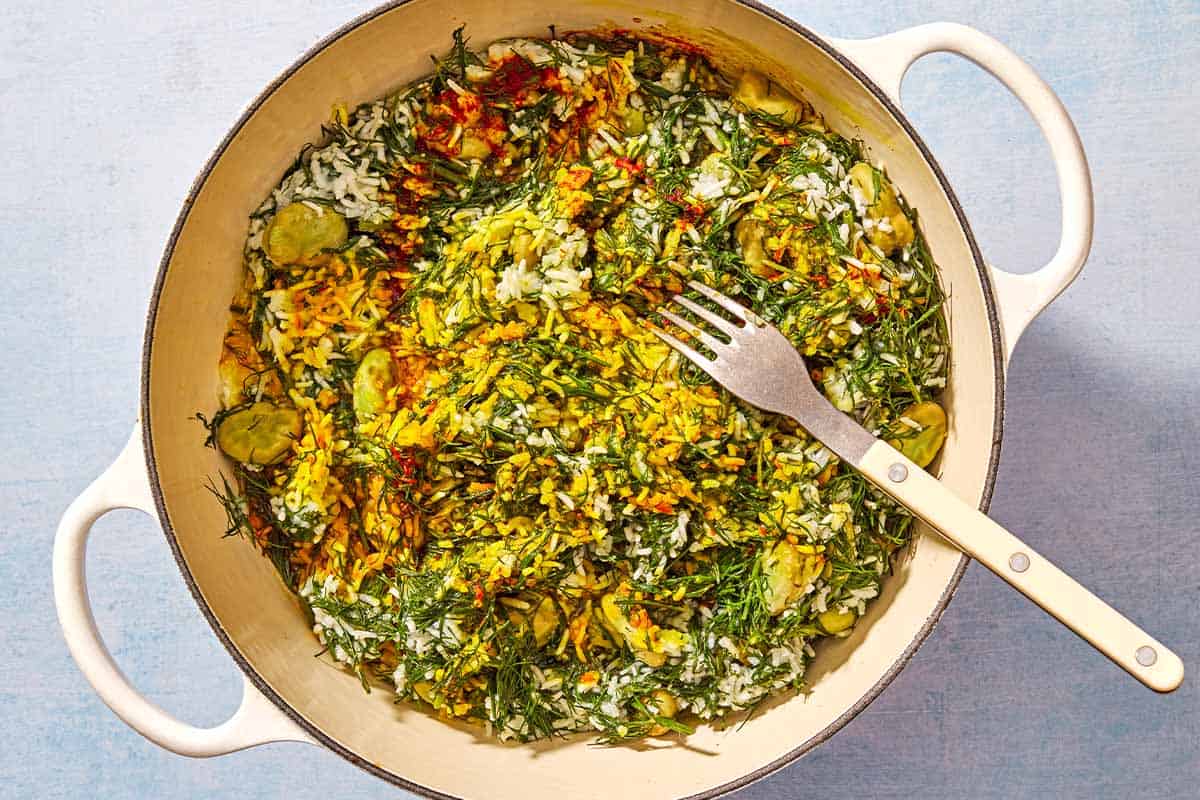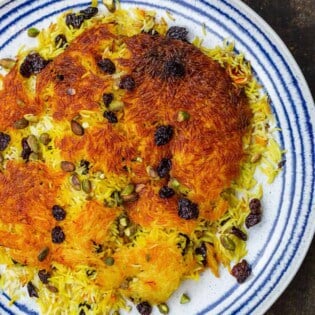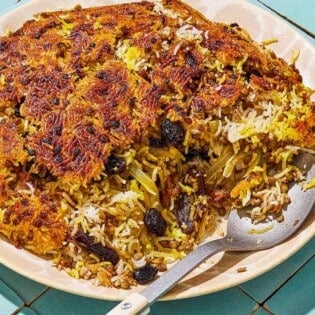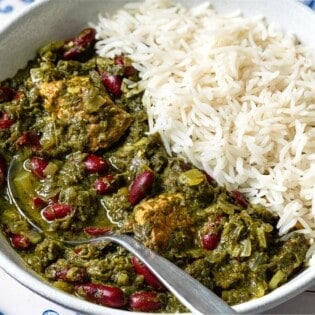Baghali Polo, or Persian dill and fava bean rice, is a beautiful dish often made for celebrations and family gatherings. It’s a pilaf-style dill rice with fava beans. It’s scented with golden saffron and includes a layer of crispy tahdig.
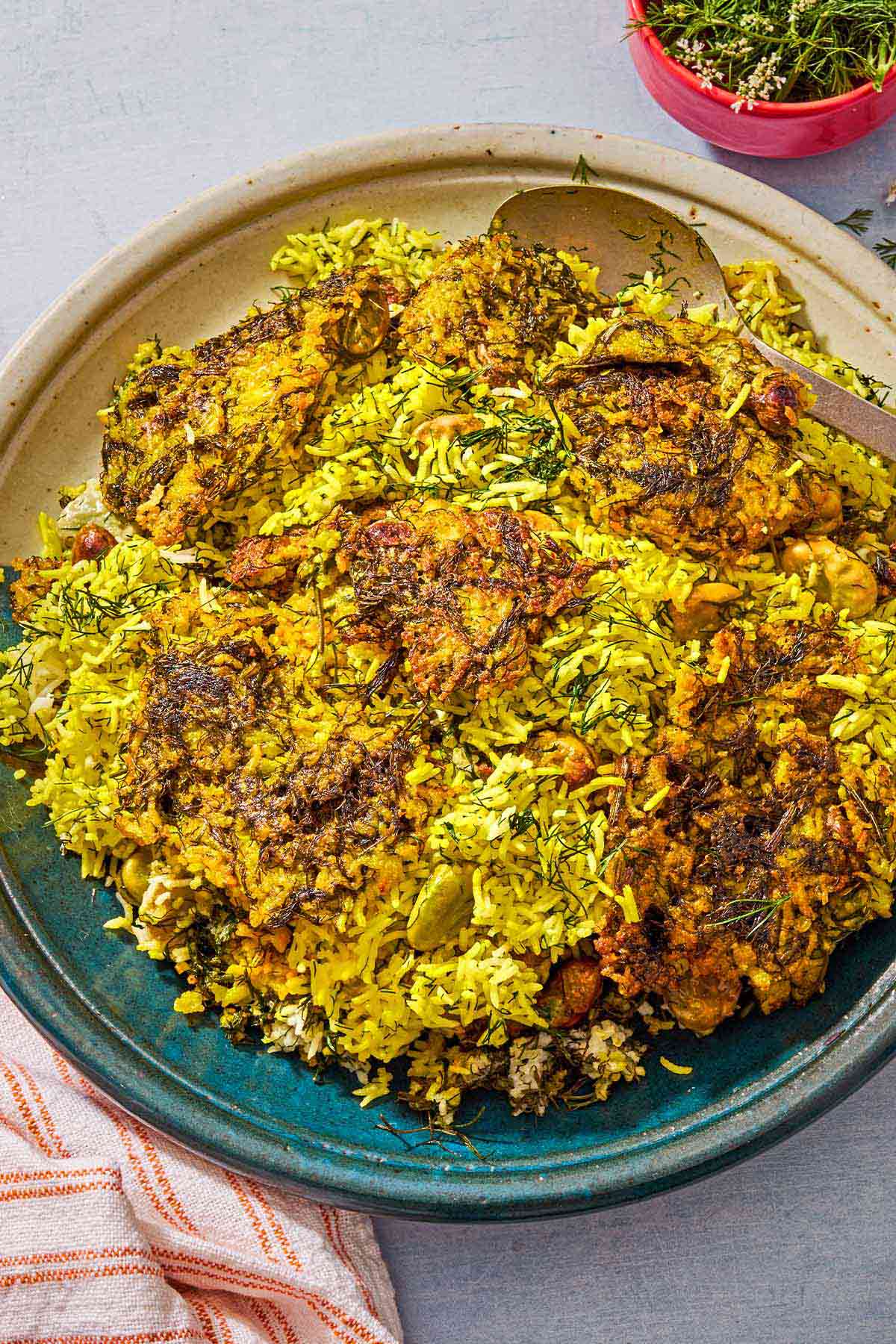
Rice is a Persian staple. We have a wide range of different rice dishes ranging from plain rice—Persian Rice with Potato Tahdig — which we eat with stews and kebabs; to rice mixed with vegetables, herbs, dried fruit, or, as in Adas Polo, lentils.
Baghali polo is one of our traditional rice dishes, where basmati rice is steamed with a generous quantity of fresh dill, tender green fava beans, and saffron. As with all Persian rice dishes, this recipe delivers tahdig—a layer of crispy rice created at the bottom of the pot.
At a Persian gathering, we often serve Baghali Polo with braised Persian lamb shanks called mahiche, but the rice takes center stage on the dining table. We pile it into a small mountain on a serving dish with specks of yellow from the saffron, dark green from the dill, and vibrant lime green from the fava beans layered throughout. I like to serve the crispy tahdig layer on a separate plate, but you can just break it up and place it on top. It’s often the first dish to be cleared!
Table of Contents
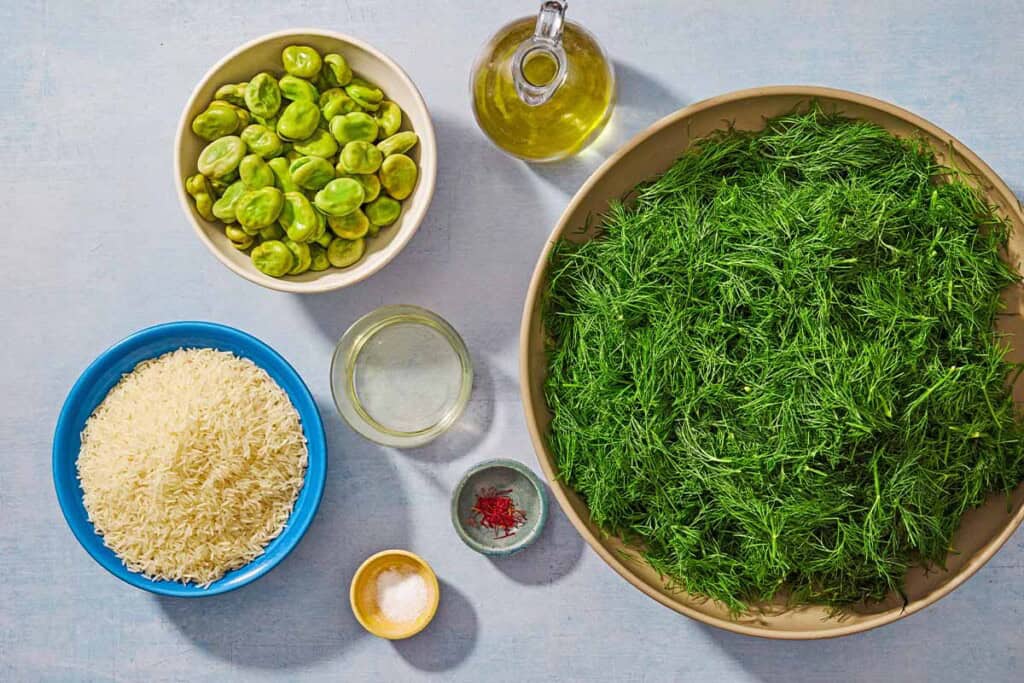
What You Need to Make Baghali Polo
To make this traditional Persian recipe, you will need the following ingredients:
- Basmati rice: a long-grain and fragrant rice, crucial for creating Persian rice dishes.
- Water is the cooking liquid for the rice, but it’s also essential for rinsing and soaking it in addition to parboiling and steaming it.
- Salt infuses the rice with seasoning as it parboils.
- Saffron adds a floral, musky aroma and flecks of golden color.
- Fava beans: Also called broad beans, are a key part of this dish. Choose either fresh fava beans and shell them yourself, or seek out frozen, shelled fava beans. I would not recommend using canned or dried favas because they lack the vibrant green color of the fresh and frozen options. If you can’t find favas, frozen shelled edamame or lima beans are the best substitute.
- Fresh dill is the starring flavor of this dish. In this recipe, it’s used more like a vegetable than an herb. Pick bunches with a vibrant green color and a strong aroma. If fresh dill is prohibitively expensive, or you can only find it sold in small quantities, feel free to supplement fresh dill with dried dill weed sprinkled in between the layers of rice.
- Vegetable oil helps crisp the tahdig layer. Persians generally use vegetable oil, but any neutral-flavored oil is fine to use.
- Extra virgin olive oil drizzled onto the layers of rice helps fluff and separate the grains once they are cooked. Traditionally, Persians use a mix of vegetable oil and melted butter or ghee, but substituting olive oil makes this version healthier.
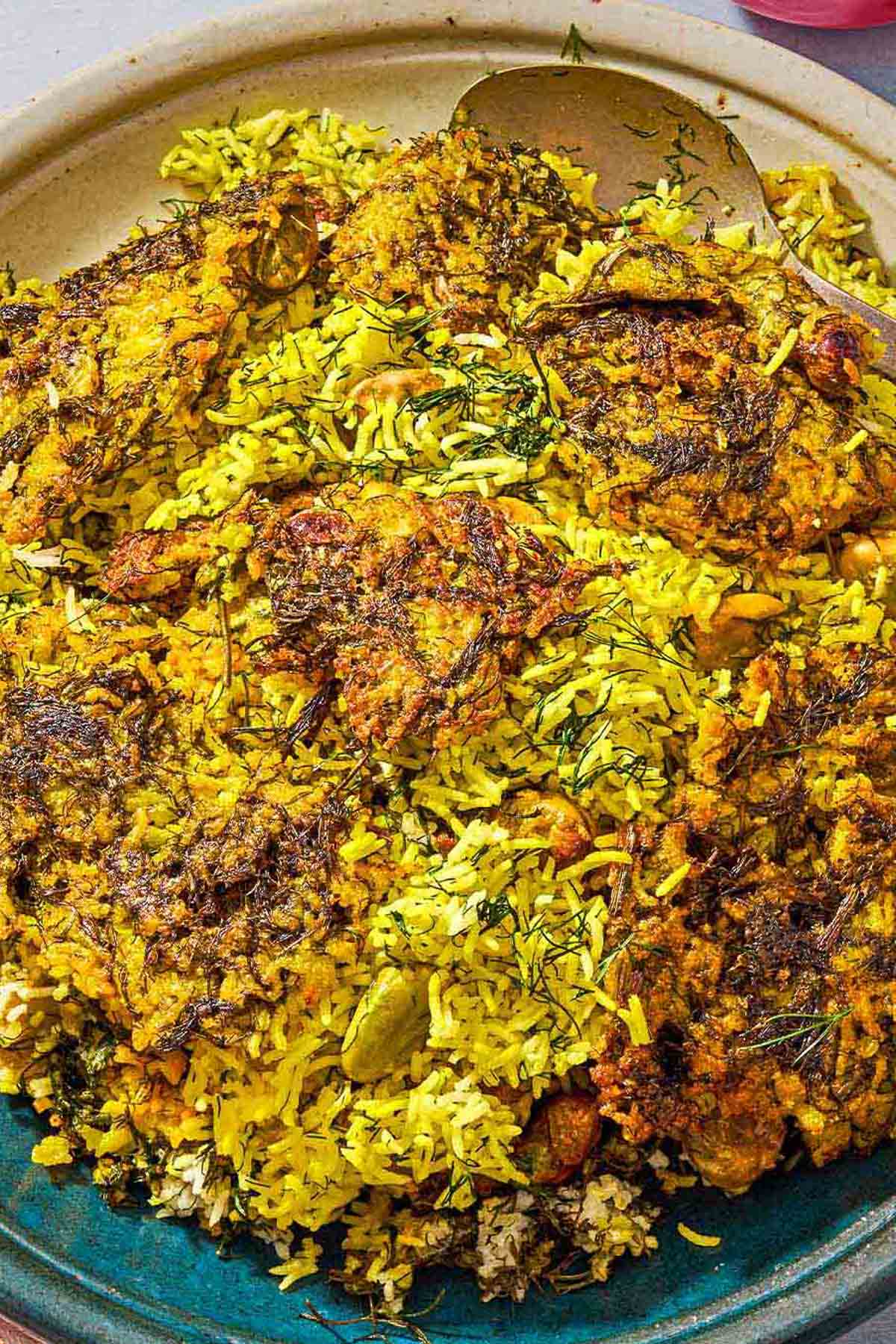
How to Make Baghali Polo
Making this baghali polo recipe requires several steps to prepare the rice because it soaks, parboils, and then steams to achieve the crispy tahdig layer. Here’s what the process looks like, step by step:
Par-cook the Rice
- Rinse and soak the rice: Rinse 2 cups basmati rice with cold water in a fine mesh sieve until the water runs clear. Place in a bowl and cover with cold water, with two inches clear above the rice. Leave to soak for a minimum of 1 hour, preferably overnight.
- Parboil the rice: Approximately 1 hour and 30 minutes before you want to serve your dish, begin cooking your rice. In a large non-stick pot, combine 6 cups of water and 1 tablespoon kosher salt. Bring to a boil over high heat. Drain and add the rice, stir, and cook uncovered until al dente, about 5 minutes.
- Bloom the saffron: While the rice boils, add 1/4 teaspoon ground saffron to 1/4 cup water and set aside.
- Stir in fava beans and dill: Add 2 cups (10 ounces) shelled fava beans to the pot of rice, followed by 10 ounces fresh dill, woody ends removed and finely chopped dill. Gently stir into the rice to distribute evenly. Turn the heat off and drain the rice into a colander. Rinse out the pot you cooked the rice in and place on the stove.
Steam the Rice
- Prepare the tahdig: Pour 2 tablespoons vegetable oil into the pot. Do not turn on the heat yet. Into a small bowl, add 2 cups of the cooked rice, dill, and fava bean mixture and 2 tablespoons of bloomed saffron water. Mix until it has turned golden. Add this rice mixture to the bottom of the pot and pat down flat with the back of a spoon.
- Spoon the rest of the rice into the pot: Then, layer by layer, add the remaining rice mixture with a drizzle of extra virgin olive oil on each layer (2 teaspoons total), creating a loose mountain shape peak in the pot. Pour the remaining saffron water over the top of the rice. Poke 5 holes evenly across with the end of the spoon.
- Steam the rice: Put the lid on the pot and turn the heat to high (you should hear the rice start to crackle). Once steam starts to rise, about 3 minutes, reduce the heat to the lowest setting. Take a tea-towel, wrap it around the lid, and place it back on the pot. Steam for a minimum of 1 hour.
- Finish and serve: Remove the lid. The rice on the bottom of the pot should be crispy, this is called the tahdig, and the rice on the top should be fluffy. Gently fluff the top rice with a fork. Then spoon into a serving dish. Lift the tahdig and serve in a separate dish in one piece or break up and place around the edge of the rice.
What to Serve with Baghali Polo
Baghali Polo is traditionally served with Mahiche, Persian Braised Lamb Shanks. Baghali Polo ba Mahiche is pretty much a complete meal with protein, carbs, and vegetables, however, we Persians often serve other side dishes alongside our mains, including salads, pickles, and Mast O’Khiar, a Persian Yogurt-Cucumber Sauce.
Salad is always a must with Persian dishes. The acid from the salad dressing adds a fresh zing to complement the myriad of rich flavors.
Shirazi Salad is the traditional and go-to salad Persians serve with their main dishes. Described as the National salad of Iran, this simple salad is made from finely diced tomato, cucumber, and red onion dressed with a zingy citrus dressing. Alternatively, any green salad of your choice with a lemon or lime-based dressing will match perfectly.
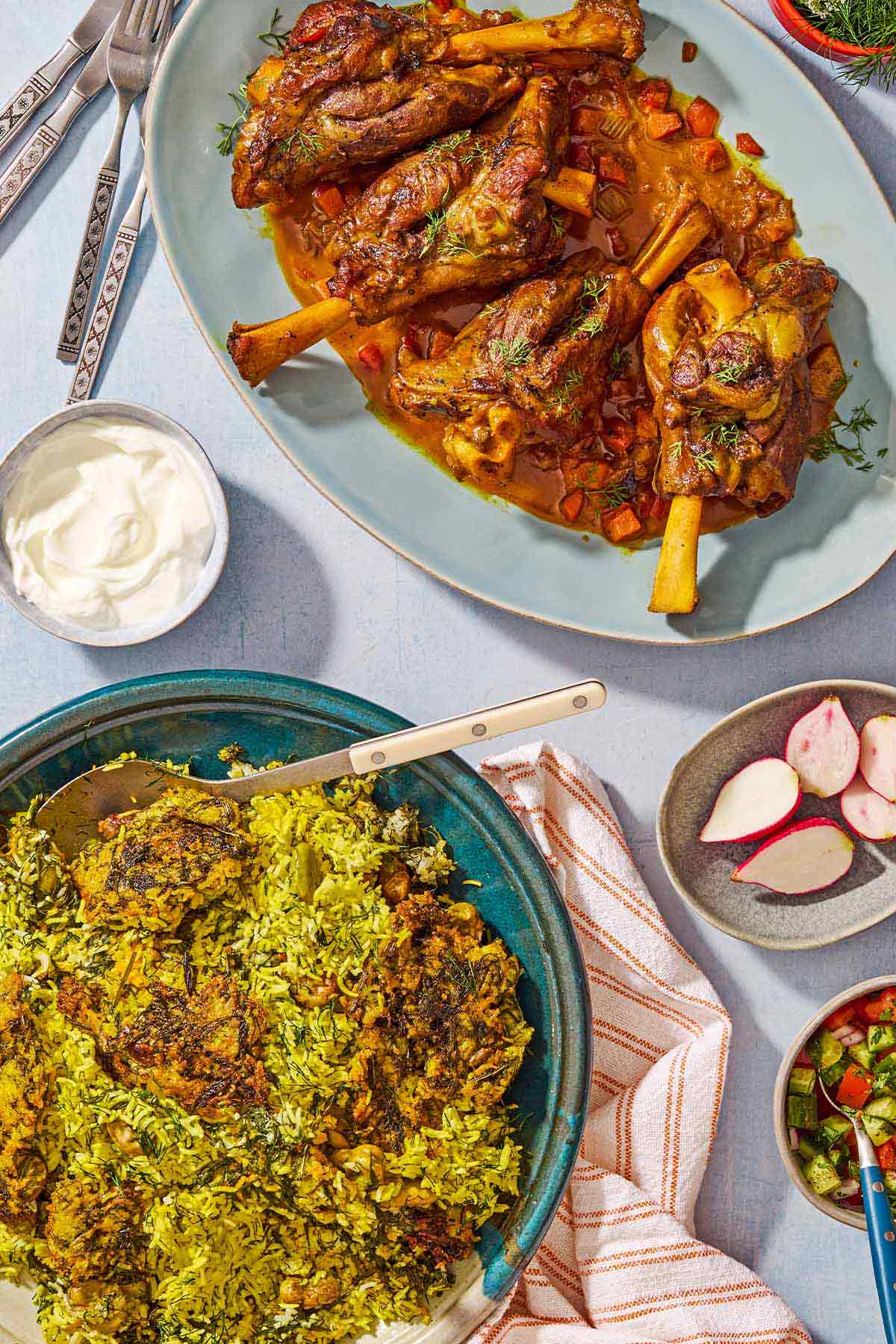
How to Store Baghali Polo
You can store this leftover dill rice in the fridge for up to 5 days if stored in airtight containers.
You can alternatively freeze leftovers. Allow it to cool completely, then transfer to freezer bags or containers. It will last for up to 3 months in the freezer.
To reheat the rice, splash a little water over it and cook on low heat on the stove. You can also reheat in the microwave using the appropriate microwave dish. To reheat the tahdig, crisp it up in a hot oven or an air fryer for about 5 minutes.
More Persian Recipes with Rice
Browse all Mediterranean recipes.
Visit Our Shop.
Baghali Polo (Persian Dill and Fava Bean Rice)
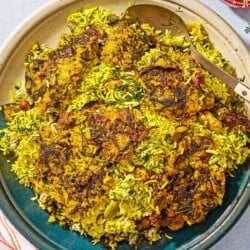
Ingredients
- 2 cups basmati rice
- 1 tablespoon kosher salt
- 1/4 teaspoon ground saffron, from about 1/2 teaspoon saffron threads
- 2 cups shelled fava beans, (10 ounces)
- 10 ounces fresh dill, woody ends removed and finely chopped
- 2 tablespoons vegetable oil
- 2 teaspoons extra virgin olive oil
Instructions
- Rinse and soak the rice. Rinse the rice with cold water in a fine mesh sieve until the water runs clear. Place in a bowl and cover with cold water with two inches clear above the rice. Leave to soak for a minimum of 1 hour, preferably overnight.
- Parboil the rice. Approximately 1 hour and 30 minutes before you want to serve your dish, begin cooking your rice. In a large non-stick pot, combine 6 cups of water and salt. Bring to a boil over high heat. Drain and add the rice, stir, and cook uncovered until al dente, about 5 minutes.
- Bloom the saffron. While the rice boils, add the saffron to a ¼ cup water and set aside.
- Stir in fava beans and dill. Add fava beans to the pot of rice, followed by the dill. Gently stir into the rice to distribute evenly. Turn the heat off and drain the rice into a colander. Rinse out the pot you cooked the rice in and place on the stove.
- Prepare the tahdig. Pour vegetable oil into the pot. Do not turn on the heat yet. Into a small bowl, add 2 cups of the cooked rice, dill, and fava bean mixture and 2 tablespoons of bloomed saffron water. Mix until it has turned golden. Add this rice mixture to the bottom of the pot and pat down flat with the back of a spoon.
- Spoon the rest of the rice into the pot. Then, layer by layer, add the remaining rice mixture with a drizzle of olive oil on each layer, creating a loose mountain shape peak in the pot. Pour the remaining saffron water over the top of the rice. Poke 5 holes evenly across with the end of the spoon.
- Steam the rice. Put the lid on the pot and turn the heat to high (you should hear the rice start to crackle). Once steam starts to rise, about 3 minutes, reduce heat to the lowest setting. Take a tea-towel, wrap it around the lid, and place it back on the pot. Steam for a minimum of 1 hour.
- Finish and serve. Remove the lid. The rice on the bottom of the pot should be crispy, this is called the tahdig, and the rice on the top should be fluffy. Gently fluff the top rice with a fork. Then spoon into a serving dish. Lift the tahdig and serve in a separate dish in one piece or break up and place around the edge of the rice.
Notes
- Shop this recipe: Visit our shop to browse quality Mediterranean ingredients including the saffron and olive oil used in this recipe.
- How to Store Baghali Polo: You can store leftover Baghali Polo in a fridge for up to 5 days if stored in airtight containers. Allow it to cool before placing it in the fridge. You can alternatively freeze leftovers. Allow it to cool completely, then transfer to freezer bags or containers. It will last for up to 3 months in the freezer.
- To Reheat Baghali Polo: splash a little water over it and cook on low heat on the stove. You can also reheat in the microwave using the appropriate microwave dish. To reheat the tahdig, crisp it up in a hot oven or an air fryer for about 5 minutes.
Nutrition
Bundle and Save!
Get the flavor party essentials to start your Mediterranean Diet Journey today!





